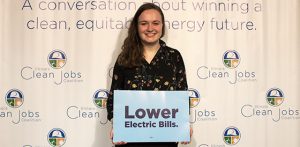
Christina Uzzo
By Christina Uzzo
CUB Environmental Outreach Coordinator
In a first in state history, the Illinois Power Agency (IPA) held a lottery to determine which proposed solar projects would receive funding through a new state program called the “Adjustable Block Program.”
Hundreds of projects won funding, including 112 community solar projects across Illinois. What we love about community solar is that it allows for people who can’t install panels at their own homes to still enjoy the benefits of solar power by subscribing to community solar gardens. (Click here for more information about community solar.)
The Adjustable Block Program was created and funded by the 2016 Future Energy Jobs Act (FEJA), which was a historic win for consumers and clean energy advocates. FEJA mandates 4,300 new Megawatts of solar and wind be built in Illinois by 2030. That’s enough to power over 570,000 average households with renewable energy! Of the mandated 4,300 Megawatts, 3,000 Megawatts will be new solar. If all that solar took the form of large solar farms, it would be enough to cover over 10,200 football fields!
For the past two years, the IPA has been working on the nuts and bolts of the program. Meanwhile solar companies worked with municipalities and counties to propose projects across the state, and utilities developed interconnection procedures on how the winning projects would connect to and supply the grid with power.
After so much hard work, stakeholder engagement, and community outreach, it will be exciting to watch this program materialize on rooftops and in fields throughout Illinois. As these first projects get built, they will answer many of the remaining logistical questions, and provide examples for future projects in Illinois.
The Adjustable Block Program, which opened to applications in January, and closed in mid-February, includes funding for 1) Small Distributed Generation (residential and small-scale commercial solar projects); 2) Large Distributed Generation (larger residential, commercial, and industrial solar installations); and 3) Community Solar.
The program has separate pots of money for different types and sizes of projects. It also separates the funding between ComEd territory and Ameren/MidAmerican territory. This ensures that a rooftop solar installation in Chicago is not competing for funding with a community solar project in Champaign.
Calling for a 2,000 percent increase in solar capacity by 2030, the Adjustable Block Program proved to be enormously popular, as solar companies rushed to propose more than 900 community solar projects to improve their chances at getting the limited funding available. In ComEd territory, solar companies proposed 433 Community Solar projects, and 78 won the lottery to receive funding. In Ameren and MidAmerican territories 34 of 486 proposed projects will receive funding. (ComEd territory has more projects because it has more energy demand.)
The community solar projects funded under the first round of the program are enough to power almost 29,000 homes.
People interested in subscribing to community solar gardens will still have to wait for the approved projects to get built and interconnected to the grid. Industry experts speculate that a few projects will be online and available to subscribers by the end of the year, but that most of the projects that just received funding will not be completed until sometime in 2020.
In addition to the community solar projects that won funding, all 740 projects proposed in the category for Large Distributed Generation in Ameren/MidAmerican territory will receive funding!
The remaining categories have not yet had enough applications to trigger a lottery – meaning that all projects submitted by the February 13th deadline will get funded. There is still a lot of funding left for future residential solar projects, even if you missed this first deadline.
Check out the full lottery results here to download the lists of which projects got funded near you! (Note: Group A refers to Ameren and MidAmerican territories, and Group B refers to ComEd territory.)

